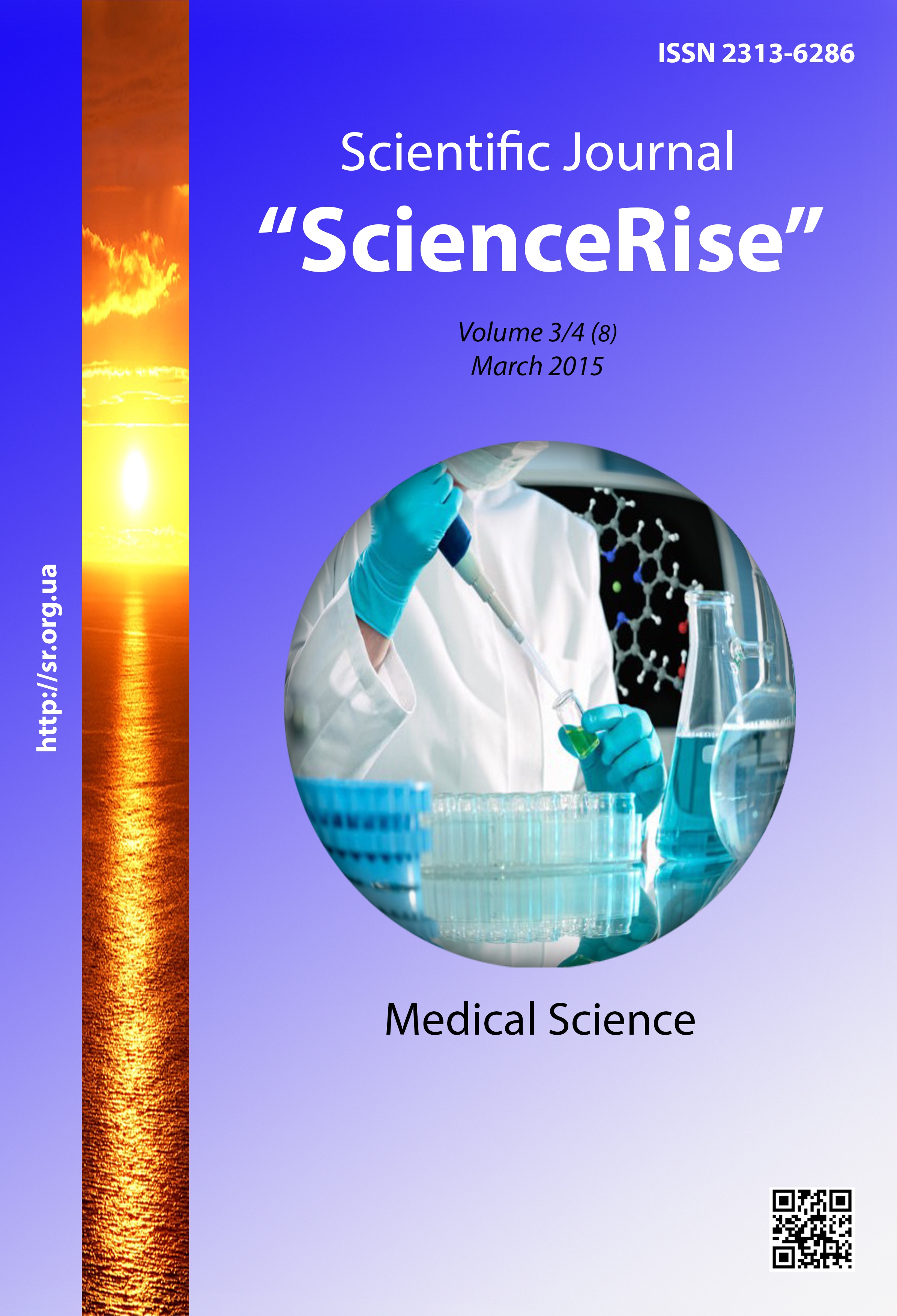Indicators of inflammatory response in chronic kidney disease and their dynamics on the background of pharmacological correction
DOI:
https://doi.org/10.15587/2313-8416.2015.38676Keywords:
chronic kidney disease, glomerulonephritis, acute phase proteins, haptoglobin, ceruloplasmin, α-2-macroglobulinAbstract
In recent years the course processes of chronic glomerulonephritis viewed from a position of influence nonimmune factors. In the present research, in contrast to the existing, it is researched an intensity of acute phase response depending on the stage of chronic kidney disease and studied the dynamics of changes of inflammatory response against the background of different pharmacological regimens.
Methods. Using standard biochemical tests to study the intensity of inflammatory response in chronic kidney disease of serum are studied protein content of acute phase: ceruloplasmin, haptoglobin, α-2-macroglobulin. The study involved 100 people. 80 of these people have chronic kidney disease. At hypertension was prescribed medicine of inhibitor of angiotensin-converting enzyme in combination with calcium channel blockers on a background of basic therapy.
Results. In all groups of patients before treatment it is recorded a high activity of serum of investigated proteins of acute phase, reflecting the presence of active inflammation. In the context of the treatment an inflammation activity is decreased, causing regression of the inflammatory response indicators. With the growth of the studied parameters in the 2 - 2, 5 times it is diagnosed a high degree of inflammatory response. This degree was determined in patients with chronic kidney disease of third stage. The lowest degree of inflammatory response was typical for patients with first stage of the disease, improving all parameters were within 1.3 times relative to control values.
Conclusions. The inflammation intensity in chronic kidney disease depends on the progression of renal dysfunction. To correct the intensity of inflammatory response is recommended to use the fixed combination of inhibitor of angiotensin-converting enzyme (fozinopril) and calcium channel blockers (diltiazem).
References
Tareeva, I. E. (2000). Nefrologiya rukovodstvo dlya vrachey [Nephrology: A Guide for Physicians]. Medicine, 668.
Shulutko, B. I. (2002).Nephrologiya [Nephrology]. Renkor, 338–359.
Lau, K. (2005). Glomerulonephritis. Adolescent Medicine Clinics, 16 (1), 67–85. doi: 10.1016/j.admecli.2004.09.008
Barsoum, R. S. (2006). Chronic Kidney Disease in the Developing World. New England Journal of Medicine, 354 (10), 997–999. doi: 10.1056/nejmp058318
Zoja, C., Benigni, A., Remuzzi, G. (1999). Protein Overload Activates Proximal Tubular Cells to Release Vasoactive and Inflammatory Mediators. Nephron Experimental Nephrology, 7 (5-6), 420–428. doi: 10.1159/000020640
Kluth, D. C. (1999). New approaches to modify glomerular inflammation. J. Nephrol., 12 (2), 66–75.
Noronha, I. L. (2002). The inflammatory component in progressive renal disease--are interventions possible? Nephrology Dialysis Transplantation, 17 (3), 363–368. doi: 10.1093/ndt/17.3.363
Severin, E. S (2000). Biohimicheskie osnovy patologicheskih processov [Biochemical basis of pathological processes]. Medicine, 304.
Alyoshkin, V. A (1988). Belki osroy phasy ih klinicheskoe znachenieacute [Acute phase proteins and their clinical significance]. Clinical Medicine, 8, 39–48.
Koruk, M. S., Taysi, M. C., Savas, O., Yilmaz, F., Akcay, Karakok, M. (2003). Serum levels of acute phase proteins in patients with nonalcoholic steatohepatitis. Turk. J. Gastroenterol., 14 (10), 12–17.
Persson, L., Engervall, P., Magnuson, A., Vikerfors, T., Söderquist, B., Hansson, L., Tidefelt, U. (2004). Use of Inflammatory Markers for Early Detection of Bacteraemia in Patients with Febrile Neutropenia. Scandinavian Journal of Infectious Diseases, 36 (5), 365–371. doi: 10.1080/00365540410020217
Rocha-Pereira, P., Santos-Silva, A., Rebelo, I., Figueiredo, A., Quintanilha, A., Teixeira, F. (2004). The inflammatory response in mild and in severe psoriasis. British Journal of Dermatology, 150 (5), 917–928. doi: 10.1111/j.1365-2133.2004.05984.x
Stroyev, E. A. (1986). Opredelenie concentracii haptoglobina v sivorotke krovi fotokalorimetricheskim metodom [Determination of the concentration of haptoglobin in serum by photocolorimetry]. Higher. School, 177–178.
Chuchelina, O. O. (2004). The method of diagnosis intensity of inflammatory response in chronic glomerulonephritis. Patent of Ukraine for useful model. G01N33/48. No 7925;declared 16.12.04.; published 15.07.2005, No 7.
Downloads
Published
Issue
Section
License
Copyright (c) 2015 Ольга Олександрівна Чучеліна

This work is licensed under a Creative Commons Attribution 4.0 International License.
Our journal abides by the Creative Commons CC BY copyright rights and permissions for open access journals.
Authors, who are published in this journal, agree to the following conditions:
1. The authors reserve the right to authorship of the work and pass the first publication right of this work to the journal under the terms of a Creative Commons CC BY, which allows others to freely distribute the published research with the obligatory reference to the authors of the original work and the first publication of the work in this journal.
2. The authors have the right to conclude separate supplement agreements that relate to non-exclusive work distribution in the form in which it has been published by the journal (for example, to upload the work to the online storage of the journal or publish it as part of a monograph), provided that the reference to the first publication of the work in this journal is included.

